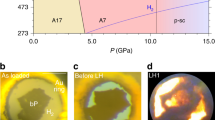Abstract
The heat capacities of thecluster compounds [Ag6M4P12]Ge6 (M=Ge, Sn) have been measured in the temperature range from 2 K to 310 K. Thermal decomposition into the elements was carried out under Knudsen conditions on a thermobalance combined with a mass spectrometer. The thermodynamic functions standard entropy, enthalpy, and the Debye temperatures were calculated from the heat capacity data. The vapour pressure functions derived from the Knudsen effusion data, served to calculate the third law heat of formation.
The rather complicated temperature dependence of the specific heat is qualitatively discussed by considering structural details and different contributions: electronic term (T≲/3 K), a threefold Schottky anomaly (ΔE 0/k=46(2) K)in the Ge-compounds (2 K⩽T⩽20 K), lattice contributions influenced by the distances Ag-Ag and atomic masses (Ge and Sn) in both compounds.
Zusammenfassung
Die spezifischen Wärmen derCluster-Verbindungen [Ag6M4P12]Ge6 (M=Ge, Sn) wurden im Temperaturbereich 2 K bis 300 K bestimmt. Die thermische Zersetzung in die Elemente wurde unter Knudsen-Bedingungen auf einer mit einem Massenspektrometer gekoppelten Thermowaage untersucht. Die Standardentropie, -enthalpie und die Debye-Temperaturen wurden berechnet. Die aus den Knudseneffusionsdaten abgeleiteten Dampfdruckfunktionen dienten zur Berechnung der Bildungswärmen. Die komplizierte Temperaturabhängigkeit der spezifischen Wärme wird für strukturelle Details und unterschiedliche Beiträge qualitativ diskutiert: fürT⩽K ein elektronischer Anteil, in der Ge-Verbindung im Bereich 2 K⩽T⩽20 K eine dreifache Schottky-Anomalie (ΔE0/k=46(2) K) sowie Gitterschwingungen, die durch unterschiedliche Abständed(Ag-Ag) und Massen (Ge und Sn) beeinflusst werden.
Резюме
В интервале температ ур 2–310 К были измерены теплоемкости класте рных соединений [Ag6M4P12]Ge6, где M=Ge, Sn. Термическое разложение их на отде льные элементы было проведено в усло виях Кнудсена с помощ ью термовесов, соединен ных с массспектромет ром. Из данных теплоемкос тей были вычислены та кие термодинамические ф ункции, как стандартная энтр опия, энтальпия и темп ературы Дебая. Функции давлен ия паров, выведенные из эффузи онных данных Кнудсен а, служили для вычисления треть его закона теплообразования. Сл ожная температурная зависимость удельной теплоемкос ти количественно обсуждена с учетом ст руктурных деталей и р азличных вкладов: электронный член (Т⩽З К), трехосная аномалия Ш оттки (ΔEo/k=46(2) К) в соединен и германия (2 К⩽T⩽20 К), решеточные вклады, за трагиваемые расстоя ниями Ag-Ag и атомными массами (Ое и Sn) в обоих соединениях.
Similar content being viewed by others
References
H. G. von Schnering and K. G. Häusler, Rev. Chim. Miner., 13 (1976) 71.
W. Hönle and H. G. von Schnering, Coll. Abstr. VI. Int. Conf. on Solid Compounds of Transition Elements Stuttgart, FRG (1979), pp. 101– 102.
J. E. Macdonald, G. A. Saunders, Y. K. Yogurtcu and W. Hönle, J. Phys. Chem. Solids, 46 (1985) 951.
J. D. Comis, C. Heremans, M. D. Salleh, G. A. Saunders and W. Hönle, J. Mat. Sci. Lett., 5 (1986) 1195.
K. Köhler, H. J. Queisser, W. Hönle, H. G. von Schnering and M. C. Böhm, Phys. Rev., B31 (1985) 6514.
W. Hönle, K. Köhler and H. G. von Schnering, (in preparation).
D. W. Bullett and G. P. Witchlow, Phys. Rev., B33 (1986) 2429.
W. Hönle and H. G. von Schnering, Z. Kristallogr., 149 (1979) 125; ibid., 153 (1981) 339.
H. Fjellvåg, W. Hönle and H. G. von Schnering, VIII. Int. Conf. of Solid Compounds of Transition Elements, Vienna (Austria) (1985) Coll. Abstr., P4 A9.
H. Neumann, V. Riede, H. Sobotta, M. S. Omar and B. R. Pamplin, Solid State Commun., 53 (1985) 155.
E. Gmelin and P. Rödhammer, J. Phys. E: Sci. Instrum., 14 (1981) 223.
E. Gmelin and K. Ripka, Cryogenics, 21 (1981) 117.
W. Schmettow, Chr. Mensing and H. G. von Schnering, Z. Anorg. Allg. Chem., 510 (1984) 51.
O. Kubaschewski and C. B. Alcock, Metallurgical Thermochemistry, 5th edn., Pergamon Press, Oxford, 1979.
E. Gmelin, A. Simon, W. Brämer and R. Villar, J. Chem. Phys., 76 (1982) 6256; R. Santandrea, E. Gmelin, C. Santandrea and H. G. von Schnering, Thermochim. Acta, 67 (1983) 263.
See for example: E. S. R. Gopal, Specific Heat at Low Temperatures, Plenum Press, New York 1966, p. 102.
V. Narayanamurti and R. O. Pohl, Rev. Mod. Phys., 42 (1970) 201.
E. Gmelin and R. Villar, Physica, 108b (1981) 1003; S. Fiechter and E. Gmelin, Thermochim. Acta, 87 (1985) 319.
H. G. von Schnering, W. Hönle, Chr. Mensing and M. Verheecke (unpublished results on the Sn-P system, 1988).
Author information
Authors and Affiliations
Additional information
Chemistry and Structural Chemistry of Phosphides and Polyphosphides 50.: H. G. von Schnering, M. Hartweg, U. Hartweg, W. Hönle, Angew. Chem., Int. Ed. Engl. 28 (1989) 56.
Rights and permissions
About this article
Cite this article
Gmelin, E., Hönle, W., Mensing, C. et al. Chemistry and structural chemistry of phosphides and polyphosphides 51. Journal of Thermal Analysis 35, 2509–2527 (1989). https://doi.org/10.1007/BF01911915
Received:
Issue Date:
DOI: https://doi.org/10.1007/BF01911915



